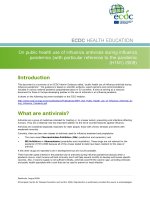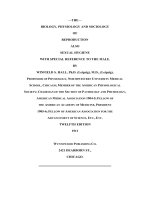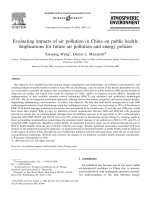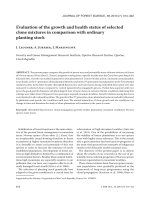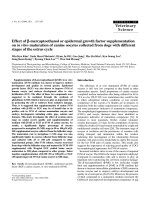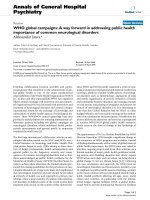On public health use of influenza antivirals during influenza pandemics (with particular reference to the pandemic (H1N1) 2009) docx
Bạn đang xem bản rút gọn của tài liệu. Xem và tải ngay bản đầy đủ của tài liệu tại đây (61.92 KB, 4 trang )
ECDC HEALTH EDUCATION
On public health use of influenza antivirals during influenza
pandemics (with particular reference to the pandemic
(H1N1) 2009)
Introduction
This document is a summary of an ECDC Interim Guidance called, “public health use of influenza antivirals during
influenza pandemics”. The guidance is based on scientific evidence, expert opinions and recommendations
included in various national pandemic preparedness plans in EU countries. It aims at serving as a resource
document for those in Europe developing policies on the use of antivirals in an influenza pandemic
It draws on the following document available on the ECDC website:
/>nza_Antivirals_du
ring_Influenza_Pandemic.pdf
What are antivirals?
Antivirals are a group of medicines intended for treating or, to a lesser extent, preventing viral infections affecting
humans. They are a relatively new but important addition to the list of countermeasures against influenza.
Antivirals are considered especially important for older people, those with chronic illnesses and others with
weakened immunity.
Currently, there are two main classes of antivirals used for influenza treatment and prophylaxis:
• The more recent Neuraminidase Inhibitors (NIs) (oseltamivir and zanamivir); and
• M2-Inhibitors or Adamantanes (amantidine and rimantidine). These drugs are not relevant for the
pandemic (H1N1) 2009 because all of the viruses tested to date have been resistant to this class of
antiviral.
A few other drugs are reported to be in development but are not yet available.
There has been great interest in the potential use of antivirals during influenza pandemics because when a
pandemic occurs, most humans will lack immunity and it will take several months to develop and license specific
vaccines. Also, if vaccine supply is not sufficient initially, antivirals could fill the vaccine ‘gap’, providing clinicians
and public health specialists with a tool that can be used to prevent or treat infection.
Stockholm, August 2009
© European Centre for Disease Prevention and Control, 2009. Reproduction is authorised, provided the source is acknowledged.
EUROPEAN CENTRE FOR DISEASE PREVENTION AND CONTROL Health Education
How effective are antivirals in a pandemic?
Antivirals can be used for both treatment and prophylaxis (administering the drug to prevent infection). The two
measures have different implications.
Treatment:
Evidence from seasonal influenza indicates that the neuraminidase inhibitors in particular (oseltamivir and
zanamivir) offer some benefits by reducing the complications and duration of an influenza illness (though usually
between one and two days) and the need for antibiotics when given within 48 hours after the start of symptoms.
Additionally, there is weaker evidence that suggests the drugs will reduce morbidity and even mortality if given
within 48 hours after the start of symptoms in sicker patients. This might encourage most doctors to give antivirals
to those who are very sick with suspected influenza.
Prophylaxis:
Antivirals can also play a role during a pandemic protecting those who are the highest risk from becoming
infected. There is some evidence that prophylactic use of antivirals could play a role during a pandemic to reduce
transmission of the influenza virus. However, benefits of this approach need to be carefully balanced against any
potential side effects and the supplies available and would need to be reconsidered if antiviral resistance emerged.
It should also be noted that the effectiveness of antivirals against a novel human influenza that will constitute a
pandemic cannot be predicted. At present, it seems both of the NIs (oseltamivir and aznamivir) can be expected
to be effective, as the influenza A(H1N1)v virus has shown no markers to be sensitive to these, but this cannot be
guaranteed to be sustained.
What are the side effects of antivirals?
Like all drugs, antivirals can have side effects for some people. To date, severe side effects are unusual for
neuraminidase inhibitors and even less common than for M2 inhibitors. However, minor side effects are quite
common, especially nausea and upset stomach for the oral preparation (oseltamivir), which is why the
manufacturer recommends taking the medication with a meal.
Can the pandemic virus become resistant to
antivirals?
Influenza viruses that are resistant to one or more antivirals can originate naturally as a result of genetic
mutations and natural changes in the virus. The possibility of a novel virus that is resistant to antiviral treatment
and that can readily transmit from human to human (referred to as a ‘fit’ virus) is a real concern. If this happened,
it might require rapid changes of antiviral policies during a pandemic.
This also highlights the importance of not relying on any single antiviral and therefore the constant need for public
support, investment and development of new therapies. Considerations should also be given to the public health
implications of ensuring appropriate prescribing practices in order to limit the risk of the emergence and spread of
antiviral resistance.
Why do countries stockpile antivirals?
The threat of a pandemic, the evolving availability of newer, more effective antiviral treatments with fewer side
effects, and concern over insufficient vaccine supplies initially led to the concept of stockpiling antivirals.
From what countries have reported, the antiviral stockpiles in European countries vary in coverage from a few per
cent of the population to more than 50%. However, even with stockpiles in place, it is almost inevitable that
EUROPEAN CENTRE FOR DISEASE PREVENTION AND CONTROL Health Education
demand for antiviral drugs will potentially exceed supply in a pandemic. Because of this, it is important that
advanced, strategic and logistical planning is carried out to optimise the usefulness of existing stockpiles small or
large.
An important general principle contends that having stockpiles is of limited use without agreed
objectives, protocols, administration and delivery systems to go with them.
Clear objective setting in advance as a part of pandemic planning activities will be crucial in order to maximise the
benefit from antiviral stockpiles. This planning should take into account:
• the total volume and availability of antivirals;
• the underlying epidemiology (projected attack rates, etc.);
• anticipated size and duration of transmission; and
• the size of population groups being given antivirals.
Who should be given priority for antiviral
use?
There are a range of different strategies regarding the use of antivirals that depend on the overall public health
goals authorities wish to attain, the availability of antivirals, and other practical considerations related to the
organisation of health systems.
Based on the available evidence, ECDC suggests the following prioritisation strategy for antiviral use:
Treatment:
1. People with more severe disease. Even if they are beyond the 48 hour ‘window’ following the start of
symptoms.
2. People most at risk of severe disease. Namely those for whom seasonal influenza vaccination is
recommended: older people, those with pre-existing chronic conditions, and healthcare workers with direct
patient contact. This may need to be modified in a pandemic to reflect those most at risk with the
pandemic strain.
3. All people just starting an illness. Within 48 hours of the first symptoms.
Prophylaxis:
4. The use of antivirals for prophylaxis can be considered by countries with larger stockpiles. Candidate
groups include close contacts of cases (especially those who are at high risk of developing severe disease),
family contacts and key workers for business continuity purposes.
Healthcare workers with direct patient contact:
5. Healthcare workers with direct patient contact represent a special case. They need to have personal
protective equipment but in addition, should they become sick, they need to receive antivirals promptly and
be excluded from work.
Please note that home stockpiles are generally not recommended.
What needs to be taken into account for
antiviral delivery and administration?
In a pandemic setting, the number of infected persons and the potential severity of disease will be considerably
greater than that observed during seasonal influenza. Therefore, managing supplies of antivirals become critical.
Furthermore, given the importance of early treatment, it is important public health policies should allocate
resources to develop protocols and management systems to ensure rapid delivery and administration.
The following operational issues require careful consideration:
EUROPEAN CENTRE FOR DISEASE PREVENTION AND CONTROL Health Education
1. In the Initiation phase of a pandemic a decision needs to be made as to whether the severity of infection at
the individual patient level is sufficient to offer antivirals to all of those with symptoms or even to attempt
delaying or containment.
2. Ensuring that there are always antivirals available for clinicians to treat those who are most ill.
3. Being able to deliver antiviral agents to people who need them most in a timely manner since, to be
effective, they have to be given within 48 hours of symptoms beginning.
4. Prioritising the key groups to receive antivirals depending on pre-agreed criteria.
5. Being able to change priorities if it seems that those most at risk are not those predicted from seasonal flu
experience.
6. Ensuring that the areas first affected do not exhaust national supplies and being able to move antiviral
resources around the country (for example, by having a strategic reserve).
7. Having a position on citizens seeking to possess individual stockpiles and companies seeking to protect
their staff.
8. Being able to change national treatment strategies if it appears supplies will be exhausted or if antiviral
resistance emerges.
9. Not burdening primary care services by making them distribute antivirals to mildly or moderately unwell
people when they are dealing with the more severely ill. Also, ensuring possibly infected persons do not
crowd together waiting for antivirals.
10. Ensuring that other key pharmaceuticals (notably antibiotics) are in sufficient supply.
11. Anticipating milder common side effects.
12. Having training materials and approaches for facilitating the use of zanamivir inhalers, especially among
those who may find them difficult to use.
13. Considering approaches for special groups, such as pregnant women and young children.
14. Having robust, reliable and tested health communication strategies aimed at professionals and the general
public concerning all the above.
In addition, ECDC suggests there are some practical systems that can operate at an EU level:
15. Member States reporting through the EWRS on their default policy positions and then on significant
changes.
16. Having systems that are able to pick up reports and rumours of adverse events and having a mechanism
with WHO, EMEA and ECDC for responding to these.
17. Monitoring emergence of resistance to antivirals.
18 Anticipating the inevitable appearance of direct internet selling from unregulated sources of antivirals and
other medications.
What are the research and development
priorities?
Research and development priorities include a need to determine whether or not antivirals are of benefit when
given outside the 48 hour ‘window’, especially in treating the more severely ill.
An additional priority includes having systems in Member States that will determine, in real time, if antivirals are
actually effective against any pandemic virus and for the early detection of treatment and prophylaxis failures,
which may be an indication of the emergence of resistance.
For further information, please see the more detailed ECDC Guidance Background Resource Paper: Public Health
Use of Influenza Antivirals in Influenza Pandemics at:
/>ics/Documents/0907_Influenza_AH1N1_Public_Health_use_of_Influenza_
Antivirals_during_Influenza_Pandemic.pdf

